Computer security professionals has received multiple reports of Boot ransomware infection. It is a new variant of malware that infects a PC, restricts user access to documents, photos and music, by encrypting them, until a ransom is paid to unlock (decrypt) them. This post will provide you with all the things you need to know about ransomware virus, how to remove Boot ransomware from your PC system and how to recover (decrypt) encrypted documents, photos and music for free.
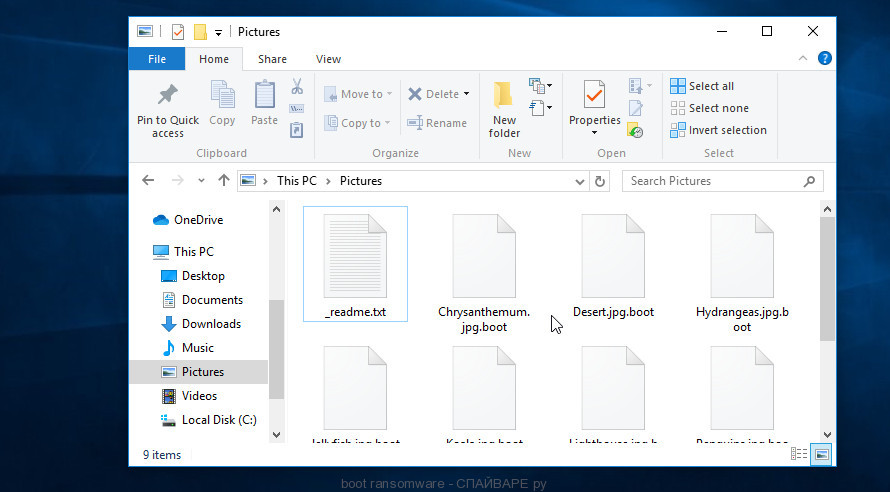
Getting to the user’s system, the Boot ransomware virus starts searching for files in all folders and recursively, and after their detection, encrypts each of them using complex ciphered combination that completely blocks them and leads to their dysfunction. This crypto virus is capable of encrypting various files like photos, archives, web application-related files, video materials, database, documents and drawings, as well as its destructive effects can be subjected to backups. Boot virus locks up almost of files, including common as:
.ncf, .mov, .sum, .kdc, .wire, .dba, .1, .xdb, .sid, .arch00, .rtf, .odc, .rim, .slm, .wma, .sav, .eps, .lbf, .zi, .wps, .blob, .pst, .t13, .txt, .x3f, .ws, .pkpass, .mpqge, .xyp, .iwi, .xx, .sql, .vcf, .wbmp, .vfs0, .syncdb, .ptx, .itm, .raf, .wdp, .fos, .xwp, .hplg, .zip, .psk, .xdl, .bkp, .dwg, .p7c, .wp, .upk, .map, .bc7, .lvl, .pdf, .m3u, .pptm, .xbdoc, .lrf, .wmf, .xml, .pfx, .1st, .wb2, .bsa, .xy3, .hkdb, .odp, .xls, .xmind, .mddata, .big, .forge, .vpk, .cas, .3fr, .dazip, .hkx, .xls, .jpe, .pptx, .qdf, .wpe, .layout, .bay, .xlsb, .png, .sb, .dbf, .x, .zdb, .wgz, .gho, .wp4, .re4, .wbz, .0, .rwl, .3ds, .xld, .kf, .zdc, .ff, .bkf, .wp6, .z3d, .ai, .der, .wotreplay, .desc, .wav, .mdbackup, .zip, .m4a, .asset, .z, .srf, .yml, .rgss3a, .gdb, .sr2, .sie, .wma, .m2, .r3d, .ybk, .wot, .bar, .wpb, .fpk, .wp5, .wmv, .qic, .p7b, .menu, .doc, .wp7, .xlsx, .pem, .py, .ppt, .y, .ntl, .pef, .rofl, .pdd, .wbm, .wcf, .xbplate, .dng, .docm, .7z, .rw2, .zabw, .xlsm, .mef, .yal, .bik, .vtf, .db0, .zw, .d3dbsp, .zif, .t12, .wmd, .xlk, .wn, .p12, .wm, .itl, .crt, .odm, .apk, .sis, .xlsm, .wbc, .esm, .xpm, .fsh, .ltx, .epk, .dcr, .iwd, .wdb, .xlgc, .x3d, .rar, .sidn, .wsh, .wri, .ibank, .flv, .nrw, .xxx, .xyw, .cdr, .bc6, .vdf, .mdb, .webp, .raw, .arw, .w3x, .wpd, .ods, .wmv, .dmp, .jpg, .jpeg, .psd, .icxs, .dxg, .hvpl, .mlx, .accdb, .cfr, .x3f, .wsd, .wpa, .wbd, .csv, .wmo, .docx, .sidd, .svg, .odt, .crw, .wpd, .mrwref, .indd, .xlsx, .erf, wallet, .cr2, .mp4, .itdb, .ztmp, .js, .wpw, .wpl, .xll, .avi, .mcmeta, .2bp, .tor
The Boot ransomware virus blocks users’ files using strong encryption, overwrites most of the content of the original files with the encrypted data and adds the boot extension to each encrypted file. The victim who sees the files with boot extension understands that they are encrypted and will remain so until he pays the attackers the required amount of money for obtaining a special key that will restore the files. Usually, the creators of the Boot ransomware leave a ransom message named ‘_readme.txt’ to users who have infected their computer with this crypto virus, indicating the required amount of ransom.
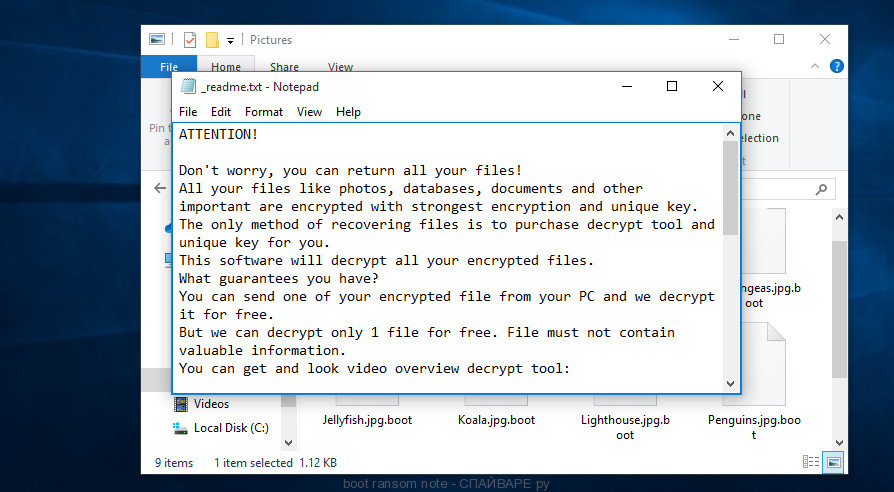
Threat Summary
| Name | Boot |
| Type | Ransomware, Filecoder, Crypto virus, Crypto malware, File locker |
| Encrypted files extension | ‘.boot’ |
| Ransom note | _readme.txt |
| Contact | gorentos@bitmessage.ch |
| Ransom amount | $980 in Bitcoins |
| Symptoms | Your photos, documents and music fail to open. You get an error message like ‘Windows can’t open this file’, ‘How do you want to open this file’. Your file directories contain a ‘ransom note’ file that is usually a .txt file. |
| Distribution methods | Phishing email scam that attempts to scare users into acting impulsively. Drive-by downloads from a compromised website. Social media posts (they can be used to trick users to download malware with a built-in ransomware downloader or click a suspicious link). Malvertising campaigns. |
| Removal | To remove Boot ransomware use the removal guide |
| Decryption | To decrypt Boot ransomware use the steps |
This article is developed for those who are looking for a way to completely delete Boot ransomware from the personal computer, and for those who want to learn as much as possible about how decrypt files. We hope you will find answers to all your questions in this article.
Quick links
How to remove Boot ransomware
There are a few solutions which can be used to delete Boot ransomware. But, not all ransomware such as this crypto malware can be completely deleted utilizing only manual methods. Most commonly you’re not able to uninstall any crypto malware utilizing standard MS Windows options. In order to remove Boot ransomware you need run reliable removal tools. Most IT security specialists states that Zemana Anti-malware, Malwarebytes or KVRT tools are a right choice. These free programs are able to search for and uninstall Boot ransomware virus from your computer for free.
Run Zemana Anti Malware (ZAM) to uninstall Boot ransomware
Zemana Anti-Malware can search for all kinds of malicious software, including ransomware, as well as a variety of Trojans, viruses and rootkits. After the detection of the Boot ransomware, you can easily and quickly uninstall it.
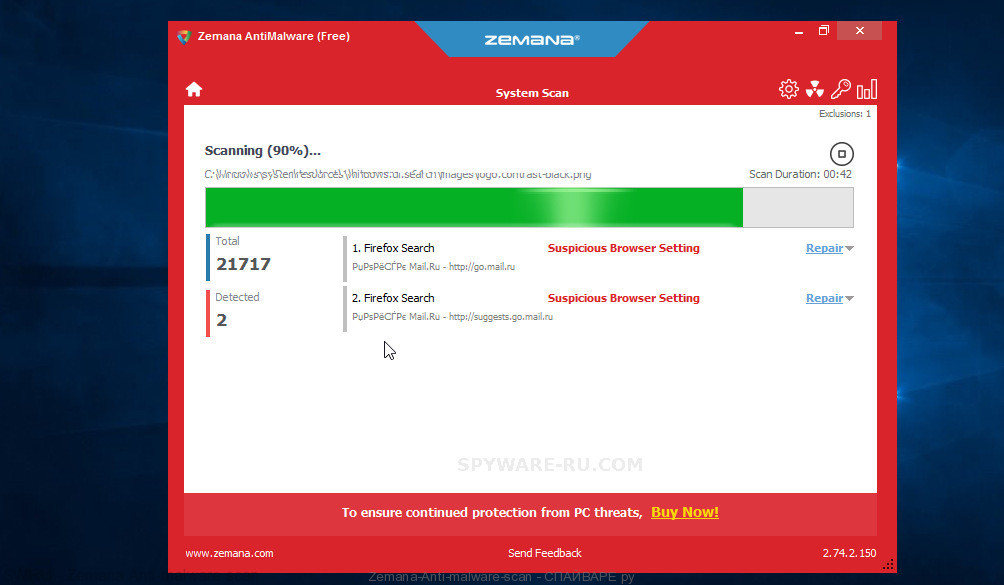
- First, click the link below, then click the ‘Download’ button in order to download the latest version of Zemana.
Zemana Anti Malware download - After the download is complete, close all applications and windows on your computer. Open a file location. Double-click on the icon that’s named Zemana.AntiMalware.Setup.
- Further, click Next button and follow the prompts.
- Once setup is done, click the “Scan” button for checking your machine for the Boot ransomware and other security threats. A system scan can take anywhere from 5 to 30 minutes, depending on your personal computer. While the tool is scanning, you can see number of objects and files has already scanned.
- Once the system scan is complete, Zemana Anti Malware (ZAM) will create a list of unwanted apps and ransomware. All found threats will be marked. You can remove them all by simply click “Next”. Once the clean up is done, you can be prompted to restart your PC system.
Remove Boot ransomware virus with MalwareBytes Anti Malware (MBAM)
Manual Boot ransomware virus removal requires some computer skills. Some files and registry entries that created by the ransomware virus can be not fully removed. We suggest that use the MalwareBytes Free that are completely clean your system of crypto malware. Moreover, this free program will help you to delete malicious software, potentially unwanted apps, adware software and toolbars that your machine can be infected too.
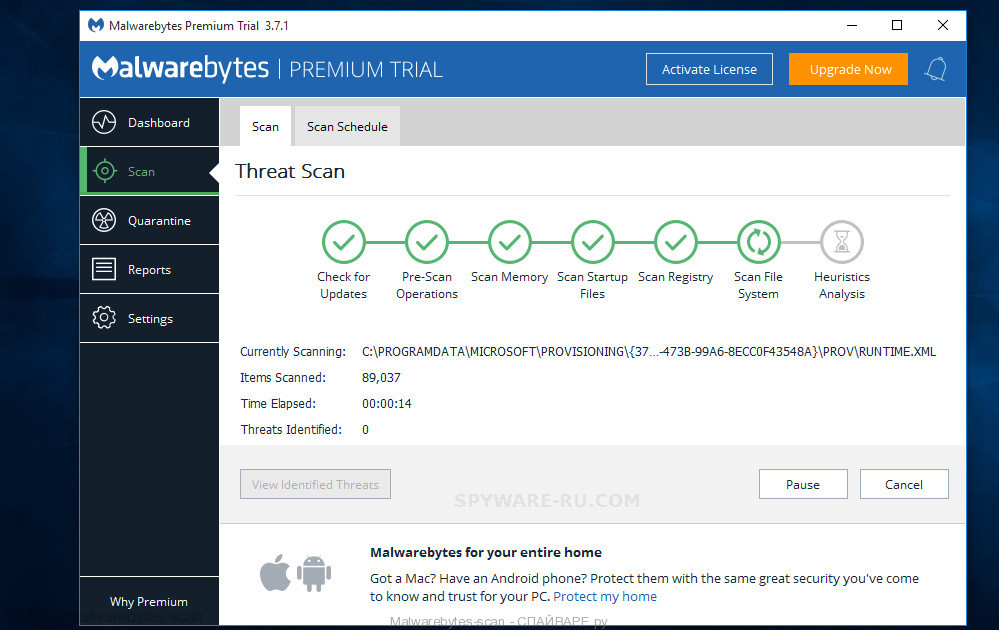
- Visit the following page to download MalwareBytes AntiMalware (MBAM). Save it to your Desktop so that you can access the file easily.
Malwarebytes Anti-Malware - When downloading is finished, close all software and windows on your computer. Double-click the install file called mb3-setup. If the “User Account Control” dialog box pops up, then click the “Yes” button.
- It will open the “Setup wizard” that will help you install MalwareBytes on your PC system. Follow the prompts and don’t make any changes to default settings.
- Once installation is finished successfully, press Finish button. MalwareBytes AntiMalware will automatically start and you can see its main screen.
- Now press the “Scan Now” button to perform a system scan for the Boot ransomware related folders,files and registry keys. A scan may take anywhere from 10 to 30 minutes, depending on the number of files on your computer and the speed of your system. When a threat is found, the number of the security threats will change accordingly.
- When the scanning is finished, the results are displayed in the scan report. Make sure to check mark the threats which are unsafe and then click “Quarantine Selected” button. The MalwareBytes Free will remove Boot ransomware virus, other kinds of potential threats such as malicious software and trojans and move threats to the program’s quarantine. Once disinfection is finished, you may be prompted to restart the personal computer.
We advise you look at the following video, which completely explains the procedure of using the MalwareBytes Anti Malware to delete adware, browser hijacker and other malware.
If the problem with Boot virus is still remained
KVRT is a free removal utility that can scan your personal computer for a wide range of security threats like the Boot ransomware virus, adware, potentially unwanted software as well as other malware. It will perform a deep scan of your computer including hard drives and Windows registry. Once a malware is found, it will allow you to remove all found threats from your machine with a simple click.
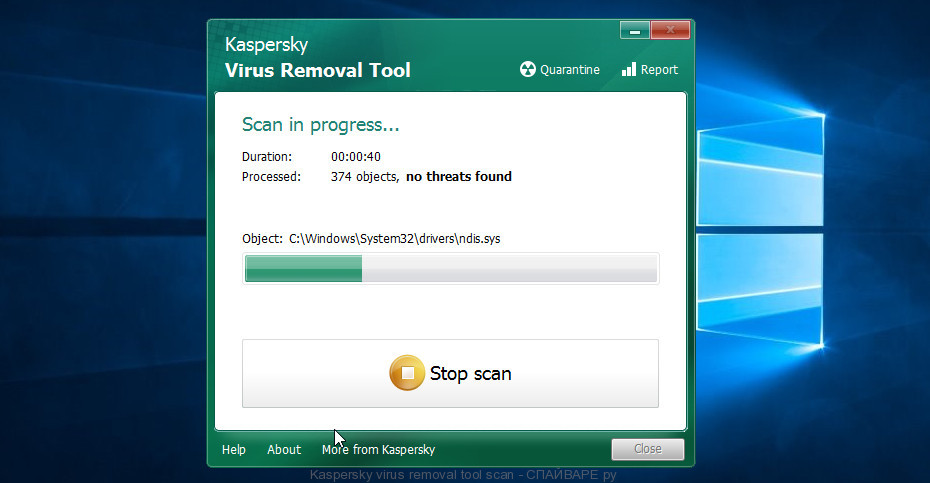
- Download Kaspersky virus removal tool (KVRT) on your Microsoft Windows Desktop by clicking on the link below.
Kaspersky virus removal tool - Once the download is done, double-click on the KVRT icon. Once initialization process is complete, you’ll see the KVRT screen.
- Click Change Parameters and set a check near all your drives. Click OK to close the Parameters window. Next press Start scan button . Kaspersky virus removal tool tool will begin scanning the whole machine to find out Boot ransomware virus and other known infections. This procedure can take quite a while, so please be patient. While the Kaspersky virus removal tool program is checking, you may see how many objects it has identified as threat.
- When KVRT has finished scanning, you will be displayed the list of all found threats on your PC system.
- All found threats will be marked. You can remove them all by simply press on Continue to begin a cleaning process.
How to decrypt boot files
To decrypt boot files, we recommend that you use the free decryptor created by Emsisoft. This decryptor will allow decrypting files that were encrypted with different versions of Stop (djvu) ransomware, including ‘Boot’ variant.
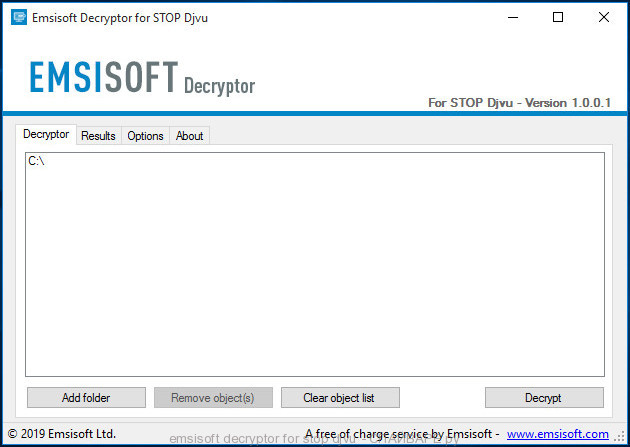
Emsisoft decryptor for stop djvu
How to use Stop (djvu) decryptor to decrypt boot files
- Visit the page linked below to download Mosk decryptor
STOP Djvu decryptor - Scroll down to ‘New Djvu ransomware’ section.
- Download the ‘decrypt_STOPDjvu.exe’ file to your desktop.
- Run decrypt_STOPDjvu.exe
- Select the directory or drive where the encrypted files are located.
- Click the Decrypt button.
Unfortunately, it does not always help to decrypt files. If Stop (djvu) decryptor skips files without decrypting them, then we advise you to use alternative methods, which are listed below.
How to restore boot files
Fortunately, there is little opportunity to restore photos, documents and music which have been encrypted by the Boot ransomware virus. Data restore programs can help you! Many victims of various ransomware, using the steps described below, were able to restore their files. In our instructions, we advise using only free and tested software named PhotoRec and ShadowExplorer. The only thing we still want to tell you before you try to restore encrypted boot files is to check your PC for active crypto virus. In our blog post we gave examples of which malware removal applications can identify and delete the Boot crypto virus.
Use shadow copies to recover boot files
In some cases, you have a chance to recover your photos, documents and music which were encrypted by the Boot crypto virus. This is possible due to the use of the tool named ShadowExplorer. It is a free program that made to obtain ‘shadow copies’ of files.
Download the program using the link that you can find below. We recommend that you save the downloaded file to your desktop, so you can easily find it after the download is complete.
When the program download is complete, you will see a file called ShadowExplorer-0.9-portable.zip. The utility is in the archive, so you need to unzip the archive before starting the program. Right-click on this file and select the option called Extract All. Now open folder ShadowExplorerPortable.
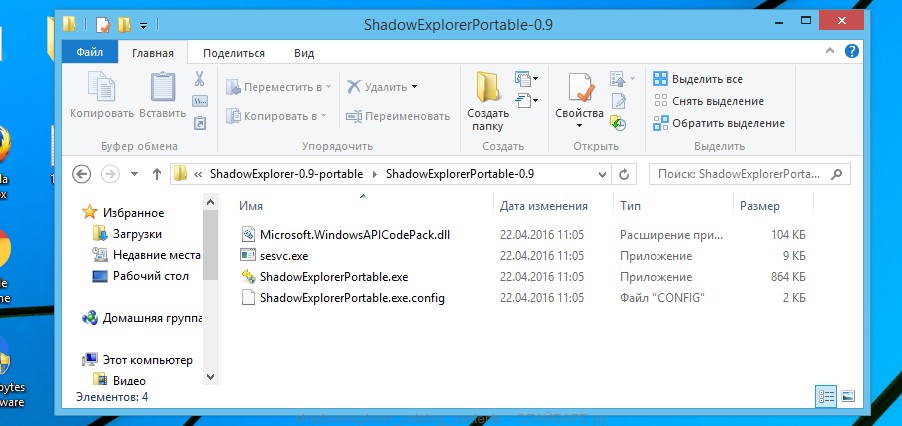
In the list of files, find the ShadowExplorerPortable program and run it.
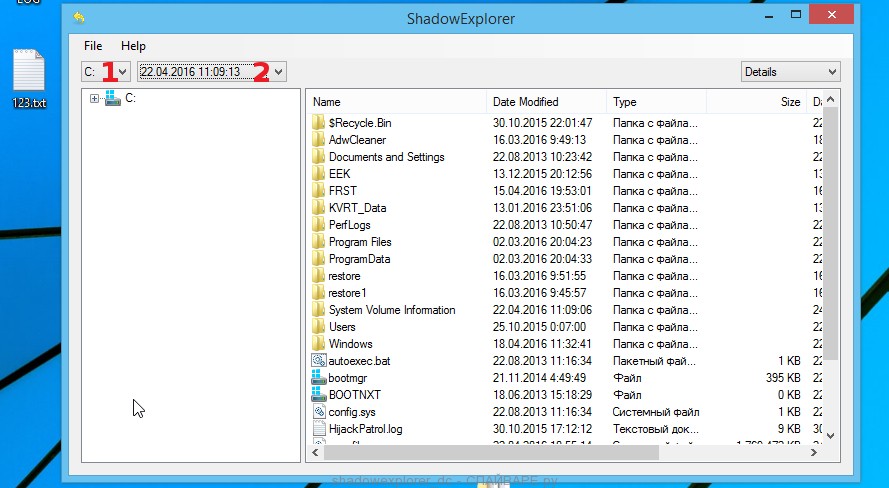
The main program window will open before you, as in the following example. The main window is divided into two parts – left and right. In the left part of the window, select the drive on which the encrypted files are located and select the date closest to the moment when the virus attacks your computer, encrypts the files and has changed the file extension to boot. In the right part of the window, select the file you want to restore, then right-click on it.
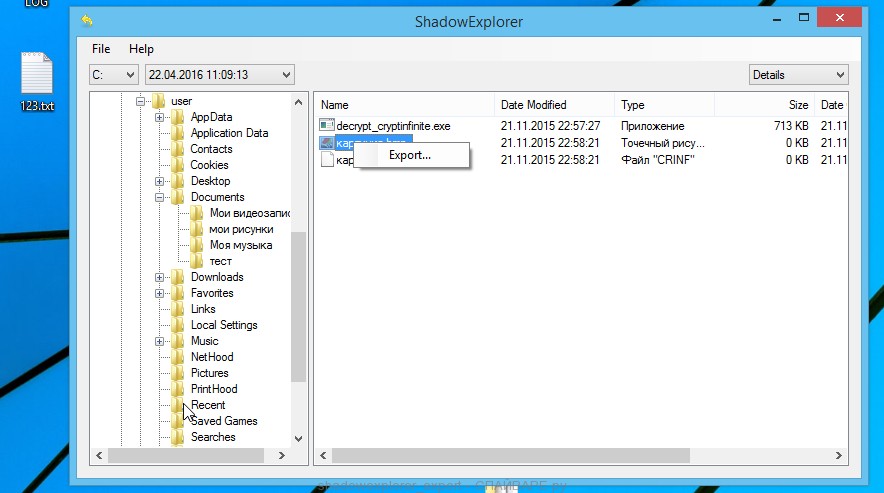
A small pop-up menu will open before you, select Export in it. In the next window, select the directory where the recovered files will be saved.
What else do I want to say about the process of recovering encrypted files using the ShadowExplorer tool. Unfortunately, very often ransomware disable the Windows Previous Versions function and delete all saved copies of files. Therefore, after starting the ShadowExplorer, you may find that it is impossible to recover files. In this case, use another method of recovering encrypted boot files, which is given below.
Recover boot files with PhotoRec
Before a file is encrypted, the Boot ransomware makes a copy of this file, encrypts it, and then deletes the original file. This can allow you to recover your personal files using file restore applications such as PhotoRec.
Use the link below to download PhotoRec.
When the file is downloaded, in the folder where you saved it you will see a file with the name ‘testdisk-7.0.win_.zip’. This file is the archive that contains the PhotoRec. To use the PhotoRec, this archive must be unzipped. Right-click on the file and select the item called Extract All. Open the folder with the name testdisk-7.0, you will see a list of files similar to the one below.
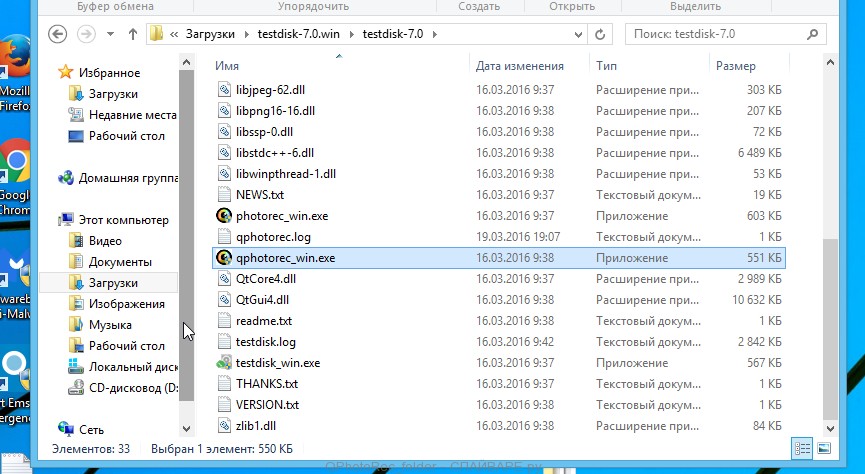
In the contents of the directory that opens, find the file with the name QPhotoRec_Win and run it. You will be shown a window similar to the one in the following figure. This is the main PhotoRec window.
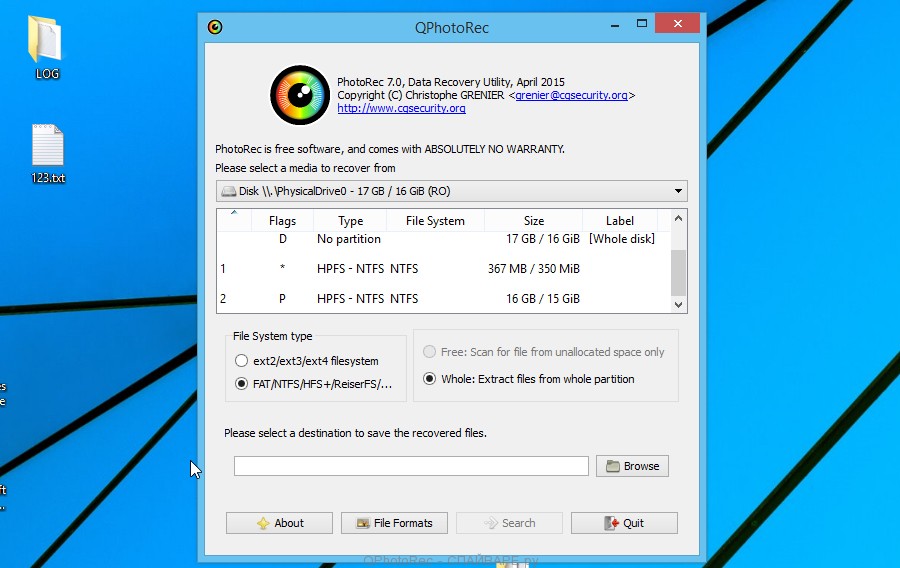
Here you need to select the physical disk and the disk partition (disk name) where the encrypted boot files are located. Note that in section ‘File System Type’, option ‘FAT/NTFS’ must be selected. Now select the folder where the recovered files will be written. We recommend using a partition or drive that does not contain encrypted files. It is better to use external media. It is very important! Since the PhotoRec restores files that were deleted by the Windows OS, if you restore them to the same drive on which you are trying to find them, a situation may occur when the Windows simply physically overwrites them and you can no longer recover such files.
Next, at the bottom of the window, click File Formats. A small window opens that lists the types of files that the PhotoRec can find and restore.
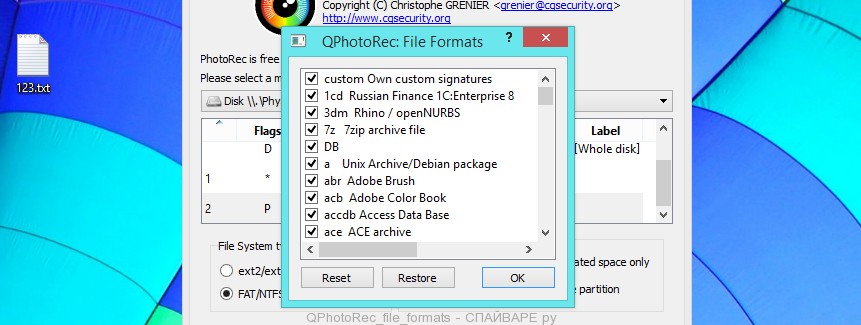
Leave only those file types that you need to recover selected. For example, if you want to restore images of ‘jpg’ format, then select the file type ‘jpg’. Having decided which files to recover, click OK button.
Having completed the steps listed above, you have made all the settings necessary to search and restore encrypted boot files. It remains only to click on the Search button. The process of searching and restoring files can take a very long time, be sure not to turn off the computer or restart it. During this process, the program will show the current search location (disk sector), how many and which files were found and restored.
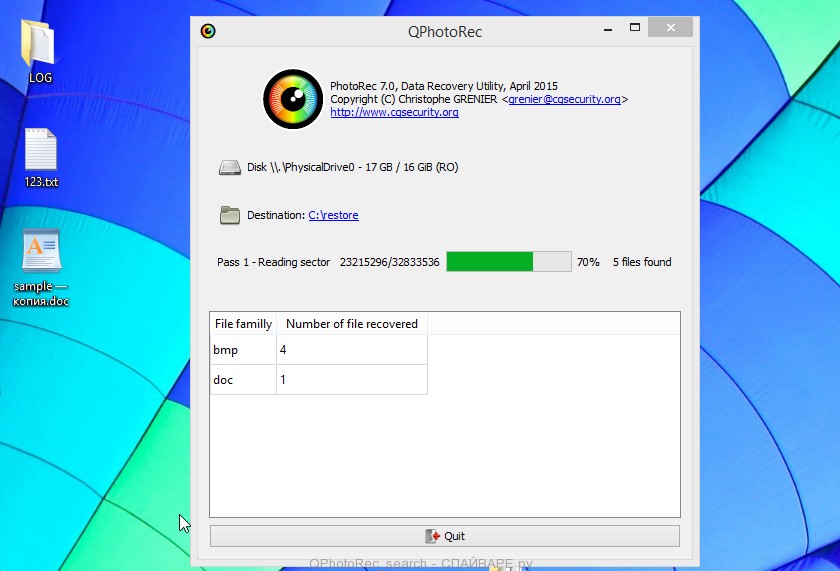
When the file recovery process is complete, click the Quit button. Then open the directory that you previously selected as the place where the recovered files will be written.
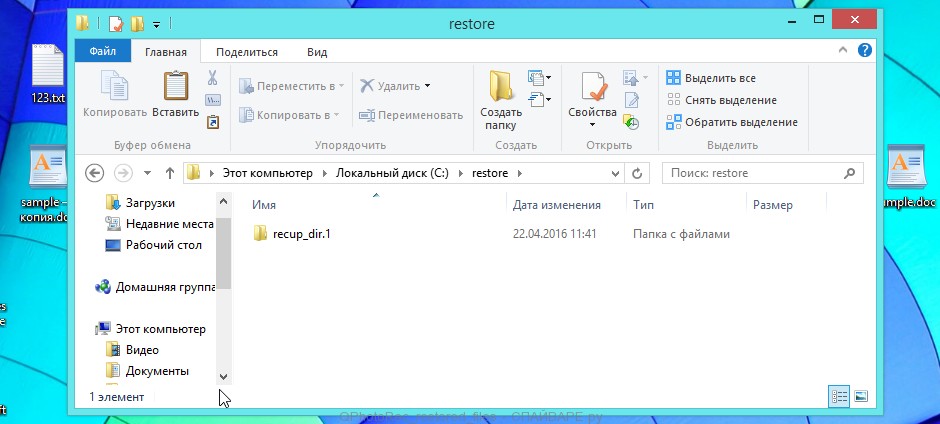
Here you will see one or more directories with the name recup_dir (recup_dir.1, recup_dir.2, …). Check these folder to find the files you need. The file name may not be restored, so to find what you need, use file sorting, as well as the standard Windows OS search by file contents.
I hope this information helped you remove Boot ransomware virus and restore the encrypted files. If you have any questions or you have information that will help readers of this article, then please add your comment below.





Hello valeri i have been attacked by .boot virus after trying so many optios i was advised to format the system and do data recovery, i have done the encrypted files back up before knowing about you and your software can i still try yours i am using easus to do recovry i hope to get them back i pray pls what do you say
You need to try to recover the files BEFORE you format the disk. Of course, if you perform quick formatting, then there is a chance that you can restore files.
Sir,
My server 2016 is affected by boot virus.
Any chance to recover , decrypt files ?
all pptx, docx, etc have become .pptx.boot
There is a chance that you can recover part or all of the files. Try the tools that I used as an example in the instructions above. Unfortunately, at the moment there is no way to decrypt .boot files. If such an opportunity arises, then we will report about it here.
Sir
I was able to recover almost 90% of the encrypted files using ShadowExplorer
Thank You very much for providing this wonderful tool.
Interesting thing is it has affected only shared Files on Win 2016 server.
Also I just had only Windows defender, but it could not do the job.
I had to install Sophos and Escan to remove and your tool to recover.
Thanks Once Again.